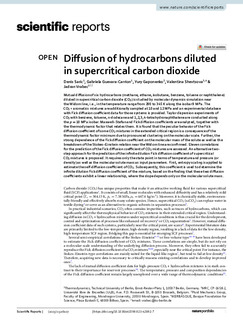| dc.rights.license | Attribution 4.0 International | * |
| dc.contributor.author | Shevtsova, Valentina | |
| dc.contributor.other | Saric, Denis | |
| dc.contributor.other | Guevara-Carrion, Gabriela | |
| dc.contributor.other | Gaponenko, Yury | |
| dc.contributor.other | Vrabec, Jadran | |
| dc.date.accessioned | 2024-04-11T08:56:37Z | |
| dc.date.available | 2024-04-11T08:56:37Z | |
| dc.date.issued | 2023 | |
| dc.identifier.issn | 2045-2322 | en |
| dc.identifier.other | https://katalogoa.mondragon.edu/janium-bin/janium_login_opac.pl?find&ficha_no=174271 | en |
| dc.identifier.uri | https://hdl.handle.net/20.500.11984/6347 | |
| dc.description.abstract | Mutual diffusion of six hydrocarbons (methane, ethane, isobutane, benzene, toluene or naphthalene) diluted in supercritical carbon dioxide ( CO2 ) is studied by molecular dynamics simulation near the Widom line, i.e., in the temperature range from 290 to 345 K along the isobar 9 MPa. The CO2 + aromatics mixtures are additionally sampled at 10 and 12 MPa and an experimental database with Fick diffusion coefficient data for those systems is provided. Taylor dispersion experiments of CO2 with benzene, toluene, n-dodecane and 1,2,3,4-tetrahydronaphthalene are conducted along the p = 10 MPa isobar. Maxwell–Stefan and Fick diffusion coefficients are analyzed, together with the thermodynamic factor that relates them. It is found that the peculiar behavior of the Fick diffusion coefficient of some CO2 mixtures in the extended critical region is a consequence of the thermodynamic factor minimum due to pronounced clustering on the molecular scale. Further, the strong dependence of the Fick diffusion coefficient on the molecular mass of the solute as well as the breakdown of the Stokes–Einstein relation near the Widom line are confirmed. Eleven correlations for the prediction of the Fick diffusion coefficient of CO2 mixtures are assessed. An alternative twostep approach for the prediction of the infinite dilution Fick diffusion coefficient of supercritical CO2 mixtures is proposed. It requires only the state point in terms of temperature and pressure (or density) as well as the molecular solute mass as input parameters. First, entropy scaling is applied to estimate the self-diffusion coefficient of CO 2 . Subsequently, this coefficient is used to determine the infinite dilution Fick diffusion coefficient of the mixture, based on the finding that these two diffusion coefficients exhibit a linear relationship, where the slope depends only on the molecular solute mass. | en |
| dc.language.iso | eng | en |
| dc.publisher | Springer Nature | en |
| dc.rights | © 2023 The Authors | en |
| dc.rights.uri | http://creativecommons.org/licenses/by/4.0/ | * |
| dc.title | Diffusion of hydrocarbons diluted in supercritical carbon dioxide | en |
| dcterms.accessRights | http://purl.org/coar/access_right/c_abf2 | en |
| dcterms.source | Scientific Reports | en |
| local.contributor.group | Mecánica de fluidos | es |
| local.description.peerreviewed | true | en |
| local.identifier.doi | https://doi.org/10.1038/s41598-023-42892-7 | en |
| local.contributor.otherinstitution | https://ror.org/01cc3fy72 | en |
| local.contributor.otherinstitution | https://ror.org/01r9htc13 | en |
| local.contributor.otherinstitution | https://ror.org/03v4gjf40 | |
| local.source.details | Vol. 13. N. art. 16107 | |
| oaire.format.mimetype | application/pdf | en |
| oaire.file | $DSPACE\assetstore | en |
| oaire.resourceType | http://purl.org/coar/resource_type/c_6501 | en |
| oaire.version | http://purl.org/coar/version/c_970fb48d4fbd8a85 | en |








